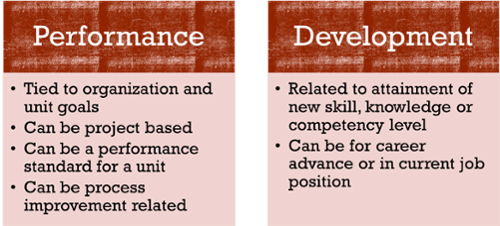Performance Management Phase I - Plan
Step 1: During this phase, the employee and manager establish a work plan for the performance cycle that includes two types of goals: Performance Goals and Development Goals.

Performance Goals:
Employees and managers meet to clarify expected outcomes for the year and set goals that link the employee's job to department and campus goals and initiatives. A focal point for the 2016-2017 performance cycle, includes the strategic initiative mandated by interim president, Staton for all departments to view student recruitment and retention as the number one priority; challenging all staff employees to view their role in this framework and identify at least one performance goal that will have an impact on student retention and success.
Performance Goals define "what" employees are expected to accomplish. These performance goals should focus on the end result of what is to be achieved. Managers and employees should aim to define S.M.A.R.T. goals.
• Specific • Measurable • Attainable • Relevant • Timely
Examples of S.M.A.R.T. Performance Goals
• Implement update of on-line graduate application program by October 1, 2016
• Reduce telephone expenses by 15% within the first half of the fiscal year.
• Identify three new funding sources by the end of FY 2016, and ensure that all grant requests are written, reviewed, and submitted to the granting agency/foundation by the respective deadlines.
In addition to identifying the goal, “how” the employee is expected to accomplish the goal should be outlined in as much detail as possible.
Development Goals:
Managers and employees should work together to create development goals. This part of the plan can focus on skills aimed at job mastery or combine job mastery with professional development skills. Job mastery skills are those that are necessary to successfully perform one's job. Professional development skills are the skills and knowledge that go beyond the scope of the employee's job description, although they may indirectly improve job performance. Development goals commonly include classes, but can also include elements such as cross-training, mentoring, special project participation and more.
Use this link to download additional goal examples.
Step 2: The supervisor will review the University competencies for success with the employee.
Step 3: The supervisor will review the job specific duties as defined by the essential duties listed on the position description.
Work Plan-Employee Responsibilities:
- Meet with manager to review and discuss the Work Plan.
- Log into PeopleAdmin Performance Management module and acknowledge Work Plan.
Work Plan - Manager Responsibilities:
- Meet with employee to review, discuss and finalize Work Plan.
- Submit Work Plan in PeopleAdmin.
This completes the first phase of the performance cycle.
To learn more:
- 229.333.5709
- 229.259.5030
-
Campus Address
University Center Bldg III
1205 N. Patterson Valdosta, GA 31698 -
Mailing Address
1500 N. Patterson St.
Valdosta, GA 31698
